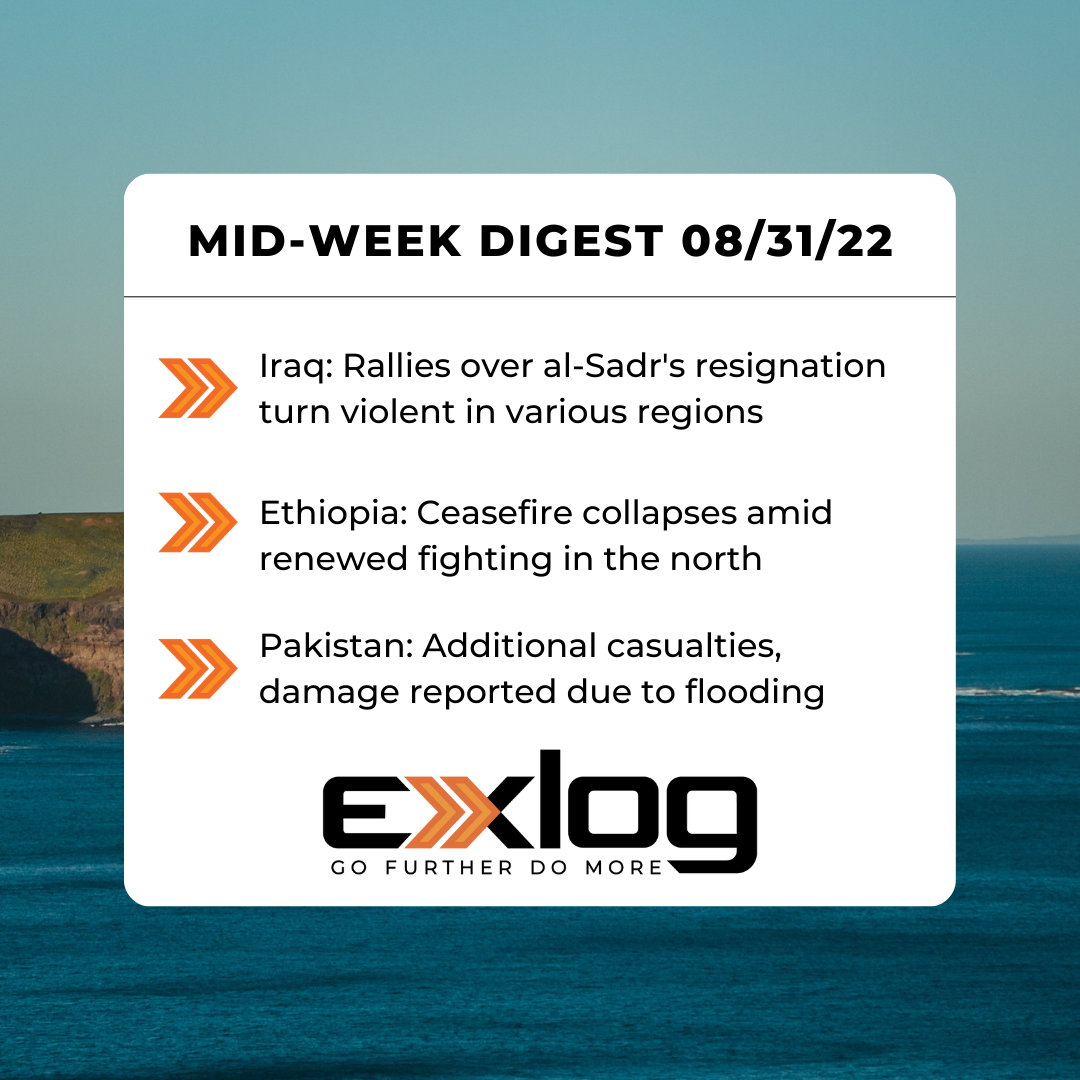pro-sadr protests turn violent in Iraq, renewed fighting in northern ethiopia, and severe flooding continues in Pakistan
Iraq: Rallies Over al-Sadr’s Resignation Turn Violent in Various Regions
Protests triggered by Shia leader Muqtada al-Sadr’s resignation turned violent in several cities across Iraq between Aug. 29-30, prompting a nationwide curfew, border closures and travel disruptions. Al-Sadr supporters broke down a concrete wall in Baghdad’s Green Zone and entered the government palace on Aug. 29, triggering a mobilization of security forces and pro-Iranian militias affiliated with the rival political alliance. Clashes between demonstrators and security forces, as well as between Sadrist and Iran-backed militias, escalated to gun and rocket fire. Health officials reported that at least 30 people were killed, and 570 others were wounded. As the unrest and clashes between rival paramilitary groups spread to other provinces – including Basrah, Dhi Qar, Maysan and Muthanna – the government implemented a nationwide curfew beginning 1900 on Aug. 29. Iran closed its land borders with Iraq and cancelled all flights to the country; UAE’s Emirates airline also cancelled all flights to and from Baghdad through August 30. The Chinese and Turkish governments issued warnings to their nationals in Iraq advising to increase security measures, while the Canadian Embassy urged its citizens to depart Baghdad. On Aug. 30, protesters began to withdraw from the Green Zone following al-Sadr’s statement calling on his supporters to refrain from violence. Iran has reopened the borders and the national curfew across Iraq has since been lifted. The recent protests follow two earlier episodes of violence inside the Green Zone in late July, when al-Sadr supporters stormed the compound and occupied the parliament to prevent a rival bloc’s nomination for prime minister. At the time, more than 125 people were injured in a confrontation with security forces when military personnel responded with water cannon, tear gas and stun grenades. Since then, protests held by both pro- and anti-Sadr groups have continued throughout Baghdad. The recent unrest follows ten months of political deadlock in forming a government triggered by parliamentary elections held in October 2021, when al-Sadr’s Sadrist Movement bloc won 73 of 329 seats but failed to reach the two-thirds majority required to nominate Iraq’s next prime minister. While al-Sadr’s address to his supporters appears to have deescalated the protests, political unrest and clashes between Sadrists and pro-Iranian paramilitary groups are likely to continue in the short-to medium term in the absence of a comprehensive government solution to improve the current political climate.
Ethiopia: Ceasefire Collapses Amid Renewed Fighting in the North
Fighting between government forces and Tigrayan rebels resumed in northern Ethiopia on Aug. 24, rupturing a five-month ceasefire between the warring sides. Neither the Ethiopian government nor the Tigray People’s Liberation Front (TPLF) has assumed responsibility for violating the truce. The TLPF claimed that government troops launched a large-scale offensive in southern Tigray, while the government accused Tigrayan forces of triggering the confrontation. Since the resumption of the hostilities, TPLF-allied forces have reportedly gained control of Kobo, a town in the neighboring Amhara region located along a highway connecting Addis Ababa and the Tigrayan capital Mekele. Government forces claimed to have withdrawn from the area to avoid collateral damage, while Tigrayan forces stated that they captured the town during a “counter-attack”. The renewed hostilities have displaced some local residents, prompting them to flee on foot due to the suspension of transportation services in the town. Local authorities in Weldiya and Dessie –located approximately 50 km (31 mi) and 170 km (105 mi) from Kobo, respectively – have imposed 1900-0600 curfews as a precautionary measure. The recent fighting follows five months of relative peace due to the implementation of a humanitarian ceasefire enacted to allow international aid into the Tigray region. Despite the ceasefire, infrastructure damage and fuel shortages have hampered relief efforts. In addition to food insecurity, the region has sustained widespread damages to power, water, telecommunications and banking infrastructure since the conflict began in November 2020. Peace negotiations have not yielded any substantial results since the implementation of the ceasefire in March due to disagreements over mediation and the lack of basic services in Tigray. Further escalation in hostilities between government and TPLF-allied forces in Tigray, Amhara and Afar regions is likely if another ceasefire agreement is not reached in the near term, further complicating the negotiation process and aggravating the humanitarian situation in the region.
Pakistan: Additional Casualties, Damage Reported Due to Flooding
The humanitarian situation in Pakistan has deteriorated further in recent weeks due to continued flooding triggered by heavy monsoon rains that has caused widespread infrastructure and private property damage and left hundreds of casualties across the country. Since the start of the monsoon season on June 14, 1,162 people have died, and 3,554 others have been injured due to the flooding; the death toll is likely to climb as the rains persist. While torrential rains and flash floods affected 30 million people across the country, most of the casualties have been reported in the states of Sindh, Khyber Pakhtunkhwa and Balochistan. The same regions also experienced the most infrastructure and private property destruction – out of more than a million houses destroyed by the flooding across the country, 95% were located in those states. Floods also destroyed or damaged more than 5,000 km (3,106 mi) of roads and 243 bridges while certain segments of national highways remain closed due to landslides. Severe infrastructure damage has significantly hampered travel and complicated search and rescue operations; the Pakistani Army has been deployed to the affected areas to assist with evacuations. Rains and subsequent floods have also interrupted supply chains, triggering price increases on basis goods. In addition, flooding has killed approximately 730,483 head of livestock and destroyed thousands of acres of farmland, which will have a lasting impact on food supply, the livelihood of farmers, and local economies. Power and communication outages have occurred throughout the country as flash floods have damaged or swept away electrical transformers. While the full extent of the economic impact is unclear, early government estimates suggest that the damages will likely exceed USD 10 billion, further exacerbating Pakistan’s economic crisis and hampering post-pandemic recovery. According to the National Disaster Management Authority (NDMA), mainly dry conditions are forecast across the country for the next 24 hours, although isolated rains and thunderstorms are expected in the south and southwest until the end of the rainy season in mid-September.


